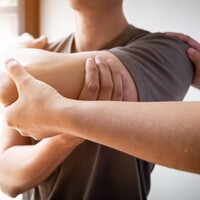
Winner of the Acupuncture Awareness Week Audience Award 2025 announced!
Looking back on the Acupuncture Week with Caspar van der Poel
Looking back on the podcast series with Marjolein Frencken
Stoptober: a fresh start for your health
From summer to autumn: letting go and finding balance

The Acupuncturist's Toolbox – Frank Ettema on Japanese Scalp Acupuncture
In this series, acupuncturists share how their style of acupuncture influences the course and outcome of treatments. This time we speak with Frank Ettema. He works at the Reade rehabilitation center and specializes in Japanese skull acupuncture. Particularly in people with neuropathic pain or a spinal cord injury, this method proves to be remarkably effective. Frank explains how he combines this approach with his background as a physiotherapist and why movement, in any form, always remains the key.
Which style do you apply when treating patients with spinal cord injuries and why does that style appeal to you?

‘For people with neuropathic pain or a spinal cord injury, I usually work with Yamamoto New Scalp Acupuncture (YNSA), also known as Japanese skull acupuncture. I came into contact with this through physician David Kopsky. He reached out to me after we had jointly treated a patient with remarkably good results. David was curious about my approach.'
Back then, I was already working at the Reade rehabilitation center and treated many patients with nerve pain, a shared area of interest. I showed him how physical exercise, for example through the Lokomat (a robot simulating a walking movement), helps the body remember how it functioned before the trauma. This 'as if' walking not only helps physically but also evokes emotions, contributing to processing.
David was already applying Japanese skull acupuncture as a doctor, and as a physiotherapist, I focused on movement. Our views complemented each other perfectly: movement is the key to circulation, of bodily fluids and energy. This combination proves powerful.
In 2010, we conducted a feasibility study together. It showed that patients often notice improvement after three treatments: In rare cases, nothing changes, sometimes the pain disappears completely, but most of the time patients experience more relaxation, pain relief, better mood, or focus.
If improvement occurs, usually nine more treatments follow. After that, the pain is often much more bearable.
After my TCM training, I further specialized in traditional Japanese acupuncture and skull acupuncture.'
Combining this style with other treatment methods — how do you ensure good coordination?
'During the first three treatments, I use only skull acupuncture. Only when we observe a change do I sometimes combine it with other approaches, such as Chinese acupuncture or breathing techniques.
Breathing exercises are especially powerful, as patients can apply them on their own—giving them a sense of control over their pain. Everything is done in close consultation. Coordination with the patient is essential: I am nothing without what they share with me.'
What does a treatment in this style look like in practice?
'The diagnosis, nerve pain, is usually already established. I then examine the nature of the pain: is it burning, tingling, radiating, or does it feel like electric shocks? Each of these sensations offers insight into which type of energy, or which element, is out of balance according to Chinese medicine.
During the treatment, I insert needles at specific points on the scalp. These points are connected to the areas where the pain is felt and are often quite sensitive. The needles remain in place for 20 to 30 minutes. Afterwards, I ask the patient whether they notice any change in their pain perception.'
What have you learned in the years that you have been working with this style, and has your way of working changed?
'In the past fifteen years, I have learned how the body relates to the natural order. As a result, I have started to see myself less as a 'doer'. The body wants to heal, and I simply help to create an environment where that becomes possible.
It's not about right or wrong, but about chaos versus harmony. Spinal cord injuries, pain, and illness cause chaos. Together with the patient, I work on restoring harmony.
Acupuncture is now included in the Spinal Cord Injury Rehabilitation Handbook, something that was unthinkable fifteen years ago. Fortunately, there is a lot of change happening in terms of accepting complementary care.
I prefer not to use the word 'healing method'. Healing is never guaranteed. Sometimes there is recovery, sometimes only pain relief or spiritual growth. Often, it is also an inner process: grief, acceptance, hope, learning to live again.
Pain management turned out to be a good starting point: where Western and Eastern medicine meet. The effect is also quickly measurable, which helps in reducing healthcare costs.
My role as an acupuncturist within a mainstream rehabilitation center is still unique. I hope that in the future, this will become more commonplace.'
Curious about more acupuncture styles?
Frank Ettema shows how skull acupuncture can contribute to pain relief and recovery, even within regular rehabilitation care. His approach demonstrates how classical Eastern principles and modern Western insights can complement each other.
Interested in other acupuncture styles? Keep an eye on our series The Acupuncturist's Toolbox!








